Growing Vanilla on Niue
Plantations in the bush on family land
The usual practice on Niue was to set up plantations in the bush on family land where there is the protection of the surrounding forest for the vines. Support trees are used, and these a vigorous growers. At times the foliage provides the dappled conditions the vines need, but at other times in the growing cycle the support trees need pruning to let in more light. Lower branches are also needed to support the vines as they will grow to great lengths and as this happens the vines are looped over a branch and then taken back to the ground and the growing tip is directed upwards again.
As growers have aged and become less nimble and able to do the pruning and clearing, this method has seen gardens close and go wild.
My concept was to have a system close to your house where water is available. Travel to the bush plantation is avoided, and to be able to go out and regularly tend to the vines pollinating during the flowering season, and being able to manage the growing vines enables the mature growers to continue growing vanilla.
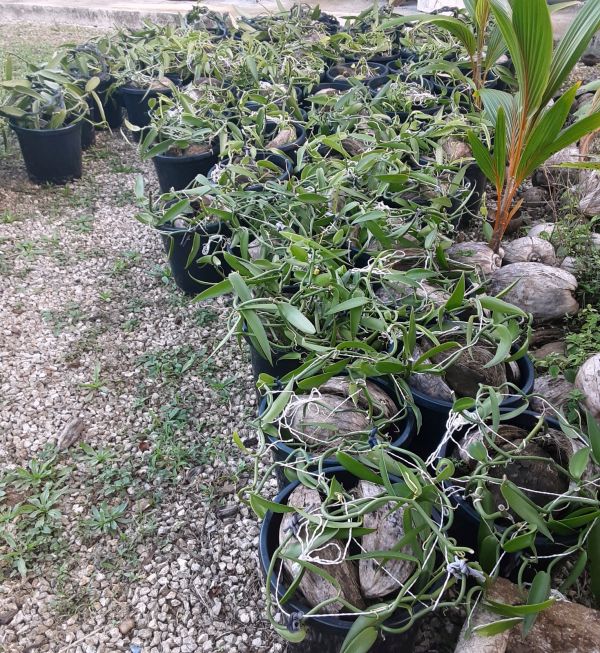
|
| Vanilla plants |
Vanilla plants
These tangled pots are 1 year vanilla plants ready to move into my growing cage and be strung up. This is a "trying something new" way of having a vanilla plot near the house for ease of attention rather than using support trees. A cutting may take three years to produce flowers.
In the first trials I did, I used pots for growing and training the vines up ropes against security fence panels. Fixing shade cloth above the panels was more of a trial, and the move to using a dog run came about as it provided an enclosed space and supports for using shade cloth.
Financing this development was assisted by a grant from the Niue Chamber of Commerce.
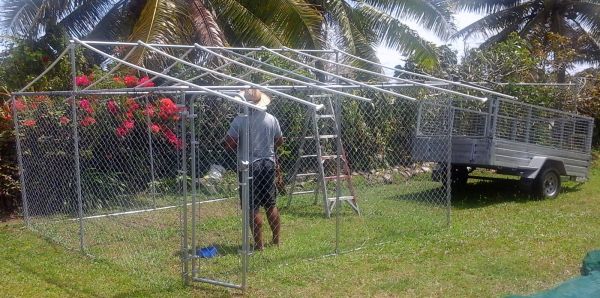
|
| The vanilla cage |
The vanilla cage
The vanilla cage was first built in the front garden. Pots were grown on here until we decided to move the cage behind the house for better weather protection. Three strong men lifted the cage and walked it around to the back yard. Job done.
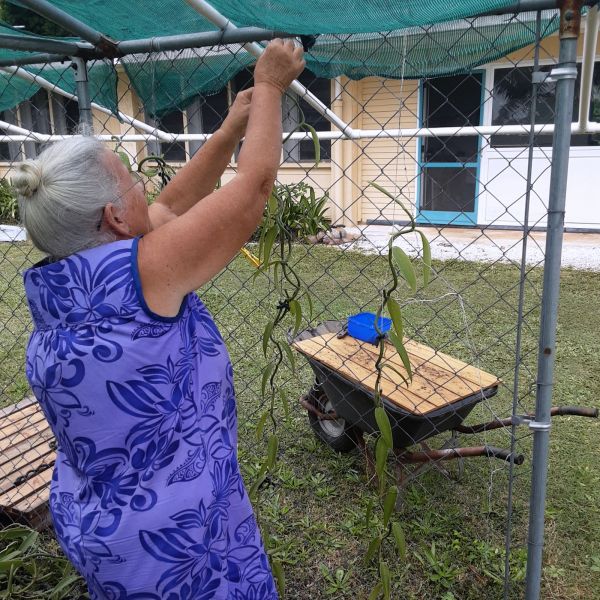
|
| Tying up strings for the vanilla vines to climb |
Tying up strings for the vanilla vines to climb
Tying up strings for the vanilla vines to climb. These were all taken down and the pots taken to the cage after it was moved to the back yard.
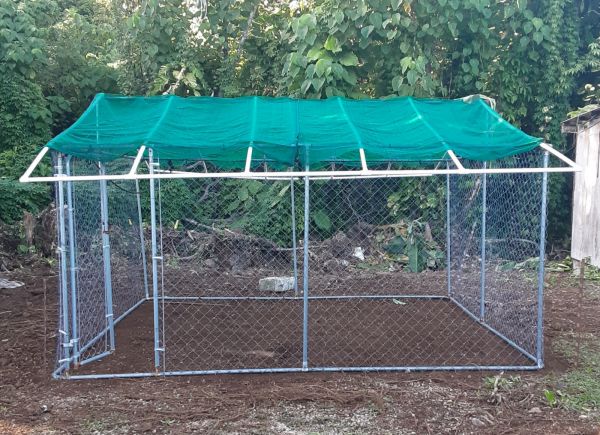
|
| My vanilla growing cage |
My vanilla growing cage
My vanilla cage (It began life as a 4x4m dog run) ready for the pots of vanilla to be set up for them to be guided up strings. Fingers crossed for flowers this season.
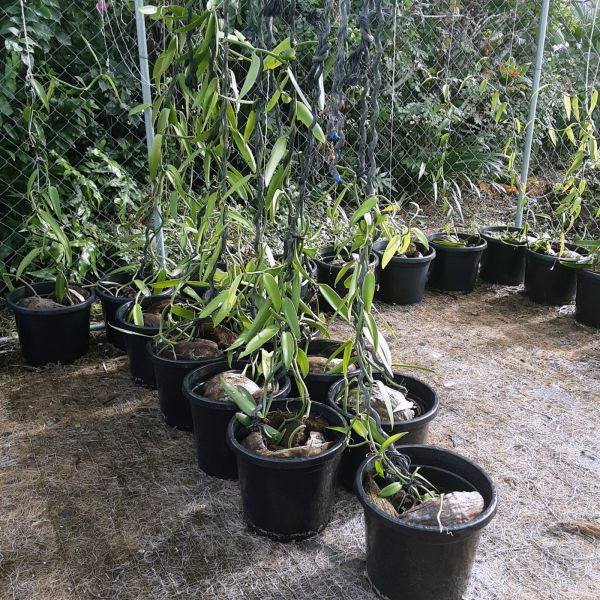
|
| vanilla cuttings are in tubs |
Vanilla cuttings are in tubs
The vanilla cuttings are in tubs with coconut husks, some compost and coconut fibre. Regular water, from the sky or the hose if there is a sunny spell, and they are happy. These are being encouraged to grow new shoots to increase potential flowering.
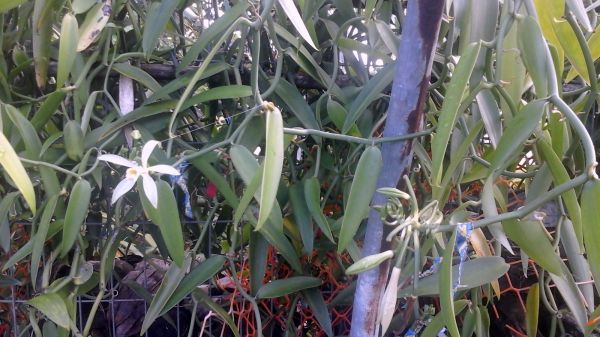
|
| Bunches of vanilla flowers |
Bunches of vanilla flowers
And this is the target. Bunches of vanilla flowers. One flower matures every day during the flowering season. Flowers last only a day and have to be hand pollinated each morning.
Other than in Mexico where vanilla is understood to have originated, hand pollinating is required.
Successful pollination starts the 9 month journey to maturity, leading to up to 5 months curing. That's where the magic happens and glossy supple vanilla pods are ready to deliver the classic vanilla flavour and aroma.
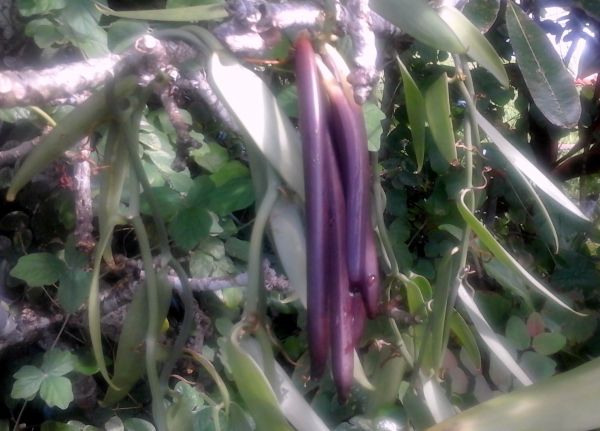
|
| Well matured vanilla pods ready for harvesting |
Well matured vanilla pods ready for harvesting
The pods resemble round green beans and at this stage have no aroma. The aroma develops as the green pods are cured. They turn dark brownish-black, are gradually de-hydrated as moisture is lost and the aroma and flavour develop. The latter part of curing is under open air shady conditions. During the cure pods are handled multiple times, checked for condition and quality. When the cure is complete the moisture content is around 25 to 30% of the original weight of the pods.
All this intensive care right through the production cycle, which can take around two years makes vanilla an expensive crop to produce,. Add to this the time to get a good extraction. But there is no other way to get the quality and flavourful results.
Salt and wind damage
In the last summer, a couple of cyclones came past Niue, hundreds of kilometers out to sea, but there was salt damage from the high winds and some of my vines perished. With some TLC the vines are growing well and the replacement cuttings are starting out. My location is not ideal, too close to the sea and in the track of the prevailing storm winds but I will be able to have a show and tell plot for visitors to see when the Island borders re-open, perhaps later in 2021.
My order
Your shopping basket is empty.
New Zealand deliveries only
Currently we only ship throughout New Zealand.
Please ask us for a shipping quote for sending our vanilla to your country.
Secure on-line ordering
Order securely on-line.
All transactions in New Zealand dollars, as displayed.
Prices include GST.

Contact Us
Email: salesblablabla@vanilla4cookingblablabla.nz
Koefaga Vanilla
49/53 Parker Street
Motueka, 7120
NEW ZEALAND
Tel: 64279444791

